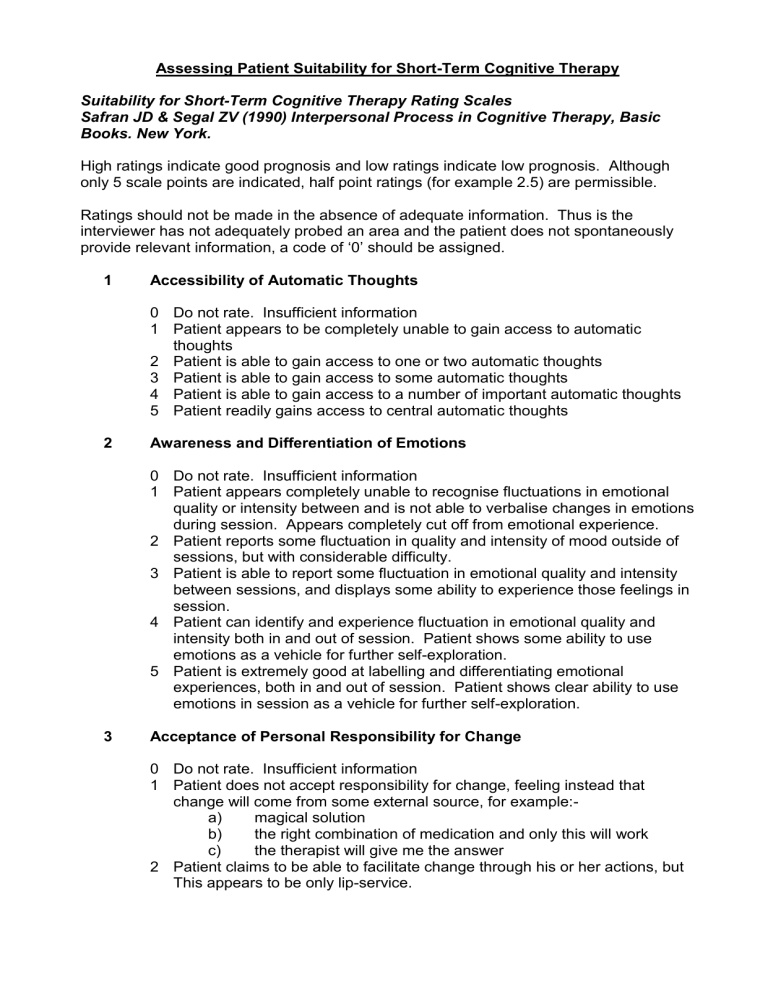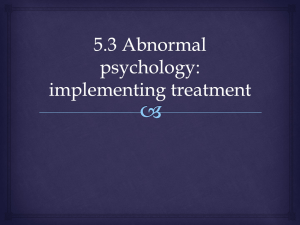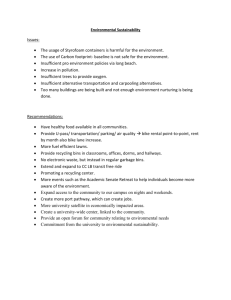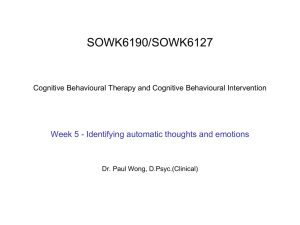Assessing Patient Suitability for Short

Assessing Patient Suitability for Short-Term Cognitive Therapy
Suitability for Short-Term Cognitive Therapy Rating Scales
Safran JD & Segal ZV (1990) Interpersonal Process in Cognitive Therapy, Basic
Books. New York.
High ratings indicate good prognosis and low ratings indicate low prognosis. Although only 5 scale points are indicated, half point ratings (for example 2.5) are permissible.
Ratings should not be made in the absence of adequate information. Thus is the interviewer has not adequately probed an area and the patient does not spontaneously provide relevant information, a code of ‘0’ should be assigned.
1 Accessibility of Automatic Thoughts
0 Do not rate. Insufficient information
1 Patient appears to be completely unable to gain access to automatic thoughts
2 Patient is able to gain access to one or two automatic thoughts
3 Patient is able to gain access to some automatic thoughts
4 Patient is able to gain access to a number of important automatic thoughts
5 Patient readily gains access to central automatic thoughts
2 Awareness and Differentiation of Emotions
0 Do not rate. Insufficient information
1 Patient appears completely unable to recognise fluctuations in emotional quality or intensity between and is not able to verbalise changes in emotions during session. Appears completely cut off from emotional experience.
2 Patient reports some fluctuation in quality and intensity of mood outside of sessions, but with considerable difficulty.
3 Patient is able to report some fluctuation in emotional quality and intensity between sessions, and displays some ability to experience those feelings in session.
4 Patient can identify and experience fluctuation in emotional quality and intensity both in and out of session. Patient shows some ability to use emotions as a vehicle for further self-exploration.
5 Patient is extremely good at labelling and differentiating emotional experiences, both in and out of session. Patient shows clear ability to use emotions in session as a vehicle for further self-exploration.
3 Acceptance of Personal Responsibility for Change
0 Do not rate. Insufficient information
1 Patient does not accept responsibility for change, feeling instead that change will come from some external source, for example:- a) magical solution b) the right combination of medication and only this will work c) the therapist will give me the answer
2 Patient claims to be able to facilitate change through his or her actions, but
This appears to be only lip-service.
4
5
6
3 Patient has some awareness that his or her efforts are important in the change process, but is fluctuating between this recognition and an externalising stance
4 Patient generally accepts responsibility for the change process but may lapse into externalising stance occasionally.
5 Patient recognises and endorses the role of his or her efforts will play in the change process, for example: - “you can point me in the right direction, but I know I have to do the work myself”.
Compatibility with Cognitive Rationale
0 Do not rate. Insufficient information
1 Patient does not see a relationship between thinking and feeling and/or clearly subscribes to an alternative model (for example, biological or psychoanalytic, which he or she views as incompatible) or clearly rejects central tasks (e.g. Homework, self monitoring) or goals (e.g. Believes that
20 sessions will not be adequate)
2 Patient has difficulty in understanding the cognitive rational and/or in seeing the value in the tasks of cognitive therapy
3 Patient appears to understand cognitive rationale, but still has some reservations or questions about the model or its applicability
4 Patient responses indicate an openness to the role of cognitive factors in distress and some willingness to experiment with the tasks of cognitive therapy
5 Patient indicates genuine acceptance of the role of cognitive factors in distress and very clearly sees the values of the important core tasks in therapy
Alliance Potential (In-Session Evidence)
0 Do not rate. Insufficient information
1 Patient clearly exhibits a lack of trust or confidence in the interviewer or explicitly expresses negative sentiments about the interview, or appears very guarded. No evidence of any rapport is evidence during the interview.
2 Patient appears withdrawn or somewhat guarded or irritable or defensive.
There is little evidence of engagement during the interview
3 Patient appears to be engaged with the interviewer, but remains somewhat untrusting.
4 There is little evidence of negative sentiments towards therapist or therapy, and the patient is reasonably involved in the interview process. There is evidence that the patient feels understood
5 Patient seems to be actively engaged with the therapist and seems to feel valued and understood. There appears to be an empathic resonance or signs of mutual warmth between patient and therapist
Alliance Potential (Out-of-session Evidence)
0 Do not rate. Insufficient information
1 Extremely poor history of interpersonal relationships. Few if any sustained relationships, all marked with mistrust or ambivalence
2 Shows evidence of some capacity to establish stable relationships, but there is a marked tendency towards mistrust or ambivalence
3 Patient displays moderate evidence of ability to establish trusting relationships, but clearly lapses into a state of mistrust when conflict arises
7
4 Shows good evidence of sustained trusting relationships with some tendency to mistrust, withdraw or avoid conflict situations
5 Patient may have interpersonal difficulties, but here is good evidence of sustained trusting, intimate relationships and ability to maintain good interpersonal contact in conflict situations
Chronicity of Problems
0 Do not rate. Insufficient information
1 A nearly lifelong difficulty with at least one of the main complaints
2 Long-lasting difficulties with at least one of the main complaints for at least 5 years
3 Patient reports main problems or complaints lasting most of the past 2 years or during at least 2 episodes in the last 6 months
4 Patient reports that main complaints or problems have existed for more than
6 months but less than 2 years
5 A relatively recent (within past 6 months) onset of the main complaints
8
9
Security Operations
Security operations can be defined as psychological and/or behavioural operations that function to reduce anxiety and raise self-esteem e.g. avoidance of topic, preoccupation with fine details, selective inattention, presenting self in exaggerated favourable lights and discussing emotional issues in an intellectually distanced way.
0 Do not rate. Insufficient information
1
The patient’s security operations appear to be sufficiently disruptive to constitute a substantial barrier to the therapeutic process
2 The patient displays security operations that are moderately disruptive, but there do seem to be some points at which he or she is able to deal with potentially anxiety-provoking issues openly and directly.
3 The patient displays mildly disruptive security operations. There appears to be some openness to dealing with anxiety-provoking topics, but there is still concern that some operations may ultimately interfere with therapy.
4 There is some evidence of disruptive security operations, but there is an impression that these are not major obstacles to therapy.
5
There is no reason to believe that the patient’s security operations will constitute an obstacle to therapy
Focality
The extent to which the patient is able to remain task-oriented and focused during the session
0 Do not rate. Insufficient information
1 Patient is unable to focus on a specific situation being worked on during the session
2 The patient is poor at focusing on a specific problem
3 The patient is able to focus on a specific problem without prompting by the therapist, and stay on task
4 The patient shows very good ability to maintain a problem focus in the absence of therapist prompting and feels comfortable working within such a structure
5 The patient shows a very good ability to work within a problem focus and uses this approach to explore fully a specific situation of importance
10 Patient Optimism / Pessimism Regarding Therapy
0 Do not rate. Insufficient information
1 The patient does not believe in the possibility of therapy being able to help change things in his or her life
2 The patient seems sceptical or pessimistic about therapy being of value
3 The patient displays some degree of hope that therapy will be helpful
4 The patient is very optimistic and hopeful that therapy can help achieve change in his or her life
5 The patient is very optimistic and hopeful that therapy can help achieve change and applies the principle







